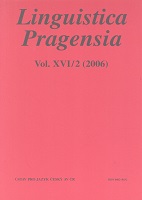EIGHTY YEARS OF THE PRAGUE LINGUISTIC CIRCLE
ARTICLE: EIGHTY YEARS OF THE PRAGUE LINGUISTIC CIRCLE
Author(s): Petr Sgall, Eva HajičováSubject(s): Language and Literature Studies
Published by: AV ČR - Akademie věd České republiky - Ústav pro jazyk český
Summary/Abstract: Eva Hajičová and Petr Sgall: EIGHTY YEARS OF THE PRAGUE LINGUISTIC CIRCLE On the occasion of the 80th anniversary of the foundation of the Prague Linguistic Circle it is important to recall at least some of the main features of the different periods of the Circle's activities and to give a brief overview of its different achievements. The authors restrict their attention to the domain of linguistics, though they are well aware of the rich results in branches other than linguistics, including besides language studies especially in aesthetics and the theory of literature, in which R. Jakobson, J. Mukařovský, as well as later M. Červenka, and others made extremely fruitful contributions. The limited space also does not allow to discuss what has been achieved by the Circle's activities in Slovakia and abroad. Attention is paid both to the older periods (1926–1945, in Sect. 1 and 2), and somewhat more detailed remarks are presented on more recent research (Sect. 3 and 4). The bibliography (which by far cannot be complete) contains a selection of relevant writings. In Section 1, the classical Circle from the 1930s is characterized as having been broadly accepted on the international scene thanks to its deeply elaborated phonological theory. The views of its main authors, i.e. N. Trubetzkoy and R. Jakobson, were far from unified; in fact, the strength of the Circle was in its spirit of dialogue, which kept the Circle receptive to new ideas, rather than in any set of postulates commonly professed. The many-sided, although not all-embracing influence of de Saussure's Cours on the views of the Praguians was combined with significant insights concerning the notion of markedness, V. Mathesius' functional and structural view of syntax and of the information structure, and also B. Havránek's account of the social and functional stratification of the national language. Among the writings of the founders' followers, V. Skalička's specification of the main concepts of synchronic grammar gave a starting point to his typology of languages. In spite of the limitations enforced by the German occupation of Czechoslovakia between 1939 and 1945, certain important results could be published, which we briefly characterize in Section 2. In Sections 3 and 4, we point out some of the main achievements the Circle gained in the first post-war years, having resumed its work under the leadership of B. Havránek, J. Mukařovský, B. Trnka, V. Skalička and J. Vachek. However, after the Communist take-over in1948, the Circle, which before that had to defend its views against attempts to implant Marrism, reacted with a less active defence against the politically supported influence of the contributions by J. V. Stalin. The Circle's name could only rarely be used in publications, and R. Jakobson (in exile since 1939) became a persona non grata. Even so, the Prague School's methods continued to be applied in domains such as typology of languages, derivatology, phonology...
Journal: Linguistica Pragensia
- Issue Year: 2006
- Issue No: 2
- Page Range: 57-76
- Page Count: 20
- Language: English

